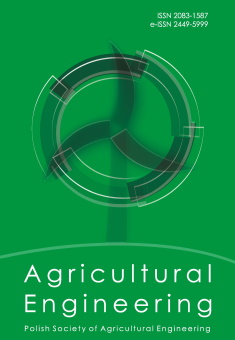The Use of the DPMO Indicator to Verify the Fulfilment of Hygienic Requirements in the Food Industry - A Case Study
DOI:
https://doi.org/10.2478/agriceng-2024-0003Keywords:
DPMO Index, food industry, occupational hygieneAbstract
The quality of the manufactured product plays a special role in the food industry. Food producers, in addition to meeting consumer requirements, are obliged to comply with legally sanctioned, rigorous requirements of hygiene and cleanliness at work, as well as the way it is performed. In order to maintain the legally required hygiene rules in production plants specializing in the production of food products, manufacturers implement numerous management systems aimed at maintaining legally imposed guidelines in the field of quality management and occupational health. The article describes the use of the DPMO indicator, which allows for a thorough analysis of process parameters affecting the final quality of the manufactured product. For the analyzed process, the maximum DPMO value for one of the areas is 636364. In nine cases, which constitutes 12.5% of the total, DPMO is 0. The purpose of this article is to identify non-compliances in the field of occupational hygiene in the production plant analyzed using the DPMO indicator and then to introduce improvements. The developed recommendations concern marking, standardization and responsibility for individual processes as well as additional cleanliness inspections.
References
Coskun, A., Oosterhuis, W., Serteser, M. & Unsal, I. (2016). Sigma metric or defects per million opportunities (DPMO): the performance of clinical laboratories should be evaluated by the Sigma metrics at decimal level with DPMOs. Clinical Chemistry and Laboratory Medicine (CCLM), 54(8), e217-e219.
Escobar, C. & Morales-Menendez, R. (2018). Process-Monitoring-for-Quality, A Model Selection Criterion. Manufacturing Letters, 15, 55-58.
Ismil, J., Saleh, M. & Rahim, G. (2018). Construction of New Standardized Attriute Control Chart based on defects per million opportunities. Qalaai Zanist Scientific Journal, 3(3), 734-745.
Kamal, E. & Parameaswari, P.J. (2021). Testing of Defects per Million Mediction Orders as a SMART Indicator for Monitoring Medication Safety in Admission and Discharge Orders. Global Journal on Quality and Safety in Healthcare, 4, 11-17.
Kielesińska, A. (2018). Food Quality And Safety In The Brewing Industry, Production Engineering Archives, 20, 16-19.
Mondal, S.K., Yin, X., Muppala, J.K., Alonso Lopez, A. & Trivedi K.S. (2015). Defects per Million Computation in Service-Oriented Environments. IEEE Transactions on Services Computing, 8(1), 32-46.
Mustaniroh, S., Widyanantyas, B. & Kamal, M. (2021). Quality control analysis for minimize of defect in potato chips production using six sigma DMAIC. IOP Conference Series: Earth and Environmental Science, 733, 1-10.
Pal, M., Aregawi, W.G. & Singh, R.K. (2016). The role of Hazard Analysis Critical Control Point in food safety. Beverage & Food World, 43(4), 33-35.
Ravichandran, J. (2016). Estimation of DPMO and EGPMO for higher the bter and lower the better quality characteristics for quality evaluation. Total Quality Management & Business Excellence, 27(9-10), 1112-1120.
Rosak-Szyrocka, J. & Abbase, A. (2020). Quality management and safety of food in HACCP system aspect. Production Engineering Archives, 26(2), 50-53.
Rosak-Szyrocka, J. & Blažević, L.B. (2019). Food safety in quality mark aspect. System Safety: Human-Technical Facility-Environment, 1(1), 558-565.
Setijono, D. (2009). The application of modified ‘Defect Per Million Opportunities’ (DPMO) and sigma level to measure service effectiveness. International Journal of Six Sigma and Competitive Advantage, 5, 173-186.
Sharma, A., Motta, V. & Martinez, L. (2019). Effectiveness of short videos to enhance HACCP information for consumers. Journal of Food service Business Research, 22(6), 549-562.
Wahyuni, H., Vanany, I., & Ciptomulyono, U. (2019). Food safety and halal food in the supply chain: Review and bibliometric analysis. Journal of Industrial Engineering and Management (JIEM), 12(2), 373-391.
Wallace, C.A. (2014). Food Safety Assurance Systems: Hazard Analysis and Critical Control Point System (HACCP): Principles and Practice. Encyclopedia of Food Safety, 4, 226-239.
Wrońska, M., Piepiórka-Stepuk, J., & Mierzejewska, S. (2017). Ocena bezpieczeństwa żywności i funkcjonowania systemu HACCP w zakładzie przetwórstwa rybnego. Inżynieria Przetwórstwa Spożywczego, 2, 28-34.
Zhang, X., He, Z., & Shi, L. (2011). Process Quality Metrics for Mechanical and Electrical Production Lin. Procedia Engineering, 24, 6-11.
Downloads
Published
Issue
Section
License
Copyright (c) 2024 Szymon Pawlak et al., published by Sciendo

This work is licensed under a Creative Commons Attribution 4.0 International License.
How to Cite
Most read articles by the same author(s)
- Klaudia Peniak, Krzysztof Nowacki, Work Safety in the Mill - Case Study , Agricultural Engineering : Vol. 27 (2023)

